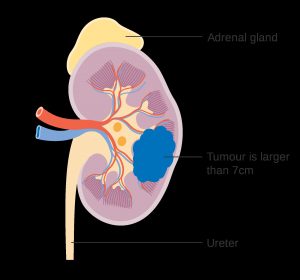Kidneys are two bean-shaped organs located on the left and right side of the spine. They sit against the back muscles in the upper abdominal cavity. They are responsible for the extraction of waste from the blood, balancing body fluids, formation of urine, and facilitating other important functions of the body.
Kidney tumours are tumours (or growths) on or in a kidney and are also known as renal tumours. They can be benign (harmless) or malignant (leading to cancer).

There are many forms of kidney tumours. Among the malignant types, the most commonly occurring type of kidney cancer is Renal Cell Carcinoma (RCC), accounting for 95% of cases in adults. The other types are Mesoblastic Nephroma (a congenital tumour, detected prenatally or after birth, before the age of 4), and Metastatic tumour or ovarian cancer. Among the benign forms of tumours are Renal Oncocytoma (a tumour made by special cells called oncocytes), Cystic Nephroma (a benign tumour that can look like an RCC and has cysts), Angiomyolipoma (most common form of benign tumours, though they can cause blood vessels to dilate and burst, leading to bleeding), Metanephric Adenoma (a rare tumour that can look like a papillary RCC) and Renal Medullary Fibroma (bland spindle-shaped or stellate-shaped cells that form a benign tumour).
Any problem with the kidneys is usually accompanied by symptoms such as difficulty in passing urine, blood in urine, pain in the abdomen, etc. However, not all kidney problems are caused by tumours. The tumours can be detected through:
1) Blood and urine tests
2) Imaging tests such as CT and MRI scans
3) Biopsy (removing a sample tissue of the kidney)
You need to be a member of MedTech I.Q. to add comments!
Join MedTech I.Q.